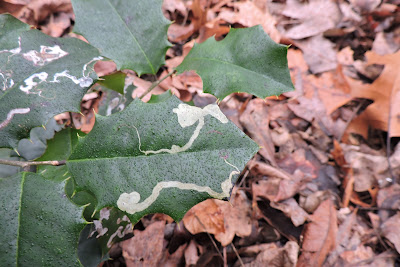 |
| Wintergreen - Teaberry- Checkerberry |
Gaultheria procumbens is a low-growing (under 6 inches) evergreen plant with a multitude of common names. Since these names are also sometimes applied to other plant species, they can sometimes confuse people. Among the variety of names used for this creeping, woodland wildflower are: Wintergreen, Teaberry, Checkerberry, Mountain Tea, Ground Tea, Mountain-berry, Partridgeberry, Canterberry, Groundholly, Boxberry, Deerberry, Spiceberry, Groundberry, and Tea Leaf. Its scientific name Gaultheria is in honor of a Canadian 18th century doctor, while procumbens means "lying flat but not rooting at the nodes" in botanical terminology.
This semi-woody plant is a member of the Ericacaea (Heath) family. Its evergreen nature, white dangling white blossoms, and long-lasting red fruit make it a very attractive plant. But its needs for very acidic soils, light shade, and dry conditions, makes it sometimes difficult to include in garden settings. Since, like many heaths, it appears to also have symbiotic partnerships with certain mycorrhizal fungi, it may not do well if those fungi are not present where it's transplanted as well. It is usually found in dry, coniferous woodlands in its natural state.
 |
| The hanging flowers of Tea Leaf. |
Wintergreen has a rich history of being utilized by people for a large variety of different reasons. Noted ethnobotanist Daniel Moerman recorded numerous uses by North America's indigenous tribes. Several Algonquian-speaking groups, including the Quebec, made a medicinal tea from Teaberry to treat headaches, colds, and other discomforts. The fruits were eaten as well. The Tete-de-Boule people used an infusion from the leaves for colds and made a poultice to apply for chest colds.
The Cherokee chewed the leaves for dysentery, indigestion, and tender gums. The berries were eaten as food, while the leaves made for a substitute for chewing tobacco. The Chippewa used Spiceberry to make tea that was used as a blood tonic, while the leaves were used as a spice. The Abnaki used it for tea, while the Shinnecock thought it could help treat kidneys, as did the Mohegan.
The Haudenosaunee (Iroquois) used Checkerberry as a de-wormer, blood purifier, and to combat venereal disease. The berries were a food source and could be used in breads. The leaves were thought to help ease colds. It was favored to treat arthritis and rheumatism. The Potawatomi also used it for rheumatism (and fevers) as did the Menominee, Oklahoma, and Lenape (Delaware).
Wintergreen has a long association for treating rheumatism, arthritis, and muscle pains. Its oils contain methyl salicylate, which has some properties similar to aspirin. Although now artificially produced, both Wintergreen and Black Birch were originally the primary sources for this substance. It was used for quite a few applications, but is most famous for its use as a liniment in such anti-rheumatism and muscle products as Bengay and Icy Hot.
During the Civil War, Southern doctor Francis Porcher was tasked with finding native plant substitutes for goods no longer available to the Confederacy due the Northern blockades. His treatise contains all sorts of uses for what could be found or produced locally. He included Wintergreen and extolled its many uses. He suggested Teaberry could be used to treat dysentery and how it was used as a substitute for tea during the Revolutionary War. Porcher wrote: "The berries, which are aromatic and pleasant, are employed to flavor spirituous liquors. An infusion of them in brandy is a convenient and useful substitute for ordinary bitters." He also recorded that "it is applied with good effect to diminish the sensibility of nerves affected by carious teeth, and to disguise the taste and smell of nauseous medicines."
Oil of Wintergreen continues to have a multitude of uses, though now it is produced artificially in most cases. Its anti-rheumatic properties have already been mentioned. But it also has been used as a aromatic flavoring in such things as teas, candies, candles, toothpaste, mints, gums, ice cream, and mouthwashes like Listerine. In the wild, leaves and berry make a fine trail nibble, but beware that some people who indulge in too much can get irritated stomachs.
 |
| Teaberry or Checkerberry |
One classic naturalist trick used in night time programs involves using Wint-0-Green Lifesavers. Due to the methyl salicylate and sugar crystal, fresh Wint-O-Green mints give a flash when they are crushed, A favorite night time naturalist activity involves having everyone bite into one at the same time in the dark while staring at each others' open mouths. When done right, the flash of light can be neat to see, and is due to what is sometimes called tribolumiscence.
Regardless of what you call it, this little native perennial is full of surprises and uses, and always has been.
























